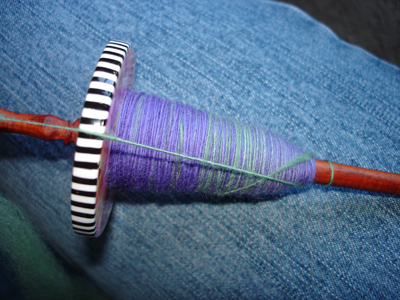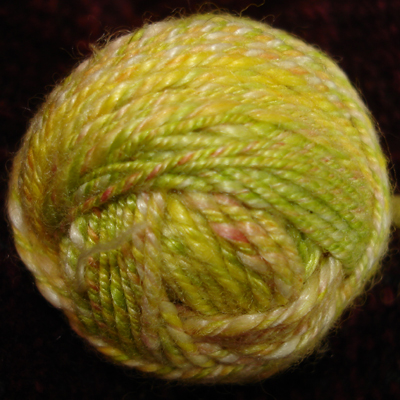
Tuesday, May 27, 2008
wrap for spindles without a notch
Most of my spindles don't have a notch, which can be a pain in the ass with slippery yarn. I finally figured out a way to wrap the yarn so it stays stable -- I wrap it below the cone of spun yarn and bring it straight up to the hook.


Thursday, May 22, 2008
zaria -- 2nd batch

I'm so pleased with this 3-ply! It's merino/tencel, and I overplied the hell out of it before I set the twist. (I was trying for a nice, tight ply and overdid it by quite a bit.) This morning I figured out how to take out the extra twist.
First, I loosely wound it on the large niddy noddy. Then I started at one end and ran an arm's length through my fingers until it had untwisted to the point of being balanced. I wound that into a tiny ball and secured it with a hair clip. Then I ran another arm's length through my hands and let the ball dangle so it would untwist. I did this for the entire 75 feet, and at the end, I had a well-balanced ball of yarn.
I feel so accomplished! I'm learning!
Wednesday, May 21, 2008
wrist distaff -- oh yes, yes yes!
Roving management is the one part of the spinning process that makes me crazy. Some people can just wrap it around their wrist and hand and everything works great -- I am not one of those people. So I decided to buy this wrist distaff to see if it would help. It's a very basic macrame distaff and falls under the category of yes I could make it, but I'd rather do something else with my time so I'll buy one, kthx.
It's fantastic! It actually works! I secure the tail of the roving in the bead cluster with a couple of figure 8s, then just wrap around the bead cluster and voila! Roving is managed, out of my way, doesn't get torn, doesn't get tangled with my single, and the distaff can double as a cat toy. (That last may not be a good thing, but Mr Eko loves it.)
If you have trouble with roving management, buy or whip up one of these babies and I'll bet you'll be glad you did.
It's fantastic! It actually works! I secure the tail of the roving in the bead cluster with a couple of figure 8s, then just wrap around the bead cluster and voila! Roving is managed, out of my way, doesn't get torn, doesn't get tangled with my single, and the distaff can double as a cat toy. (That last may not be a good thing, but Mr Eko loves it.)
If you have trouble with roving management, buy or whip up one of these babies and I'll bet you'll be glad you did.
non-etsy roving: sakinaneedles.com
http://sakinaneedles.com
BFL & SW merino roving in beautiful colors. It's interesting to compare how the colorways look in the different fibers. SW merino seems to come out brighter, BFL softer and lighter.
In SW merino, I like Blood Orange, Briar Rose, Pinyin Pine, Rhubarb Pie, and Watermelon.
In BFL, I like Callow Lily, Popsicles, Squashed, and Tabsula Rosa.
BFL & SW merino roving in beautiful colors. It's interesting to compare how the colorways look in the different fibers. SW merino seems to come out brighter, BFL softer and lighter.
In SW merino, I like Blood Orange, Briar Rose, Pinyin Pine, Rhubarb Pie, and Watermelon.
In BFL, I like Callow Lily, Popsicles, Squashed, and Tabsula Rosa.
spindle longing -- Tracy Eicheim
I desperately want one of Tracy Eicheim's floral rimmed spindles. He's not taking orders until the fall, so I'll just have to wait. (And watch spunkyeclectic.com just in case one shows up!)
Isn't it lovely?
Isn't it lovely?
Friday, May 16, 2008
bfl, my new favorite fiber
A while back, I bought a 5 fiber sampler pack from spinningbunny.com. Last night, one of my new spindles arrived and I decided to break out the BFL from the sampler pack to play with. I've seen some nice BFL rovings on etsy and wanted to know if I liked playing with it.
OH MY GOD. OH MY GOD. This is the easiest fiber I've ever worked with! It flows through my hands, it spins up insanely thin and even, and it's soft as hell. I usually avoid non-superwash wool like the plague, but I could dive into a vat of this stuff. I want more, and now!
Also, the funky gothic spindle? LOVE IT. It's light and fast and spins like a dervish. It's my second 3" diameter spindle, and I am surprised by how much I like that size. The millefiori spindles are 2-1/8", and that turns out to be as small as I want my spindles to be. The 3" spindles spin faster and longer, and I can usually draft an arm length's worth in one spin.
OH MY GOD. OH MY GOD. This is the easiest fiber I've ever worked with! It flows through my hands, it spins up insanely thin and even, and it's soft as hell. I usually avoid non-superwash wool like the plague, but I could dive into a vat of this stuff. I want more, and now!
Also, the funky gothic spindle? LOVE IT. It's light and fast and spins like a dervish. It's my second 3" diameter spindle, and I am surprised by how much I like that size. The millefiori spindles are 2-1/8", and that turns out to be as small as I want my spindles to be. The 3" spindles spin faster and longer, and I can usually draft an arm length's worth in one spin.
spinning: definitely not a phase
Goldenbaer taught me to spin a few years ago at a 4th of July party. I had never touched a spindle before, and he was extremely kind about sacrificing what he was working on to teach me. It was all kind of hilarious, because we weren't really used to being in the same place yet, and we kept getting holy shit, are they going kill each other, wtf? looks. Shortly thereafter, he gifted me with a Very Solemn Sheep spindle (tm Badcat, technically a Louet wooden spindle) and a gigantic ziploc full of 3 kinds of nice roving. Every now and then I'd pull it out and futz with it, but I had forgotten almost everything.
Fast foward to the first weekend of April 2008, the DFW FiberFest. Both Waterlylly and Badcat bought spindles and roving. I was tempted, but decided against it because a) it was a total impulse, b) I had already blown the back out of my budget at the show, and c) I don't knit as much as I want to as it is, and a new hobby is just going to make that worse. Good reasons, yes? Well, the following Thursday, Lyl brought her new spindle over and spun while I knit and watched her like a cobra watching a mongoose. It was positively hypnotic. She showed me what she was doing and put her spindle in my hand and that. was. it. After she left, I dug out the supplies from Goldenbaer.
That was on April 10th. Since then, I've spun every day, good or bad. I've spun regular wool, superwash merino, sw merino/tencel, and bamboo on a modest variety of spindles. I (obviously) haven't settled down to One Big Spinning Project, because I'm me, but I have plied test yarn and verified that I'm actually making something I can use. (Woo!) I'm no more capable of fiber monogamy than any other kind, and I'm really enjoying playing with different fibers and figuring out what I like. I'm almost ready to settle down a bit and start working on my technique with each fiber.
My mom is wildly curious as to what this "spinning" entails. I can't wait to show her, I think it will blow her mind.
Fast foward to the first weekend of April 2008, the DFW FiberFest. Both Waterlylly and Badcat bought spindles and roving. I was tempted, but decided against it because a) it was a total impulse, b) I had already blown the back out of my budget at the show, and c) I don't knit as much as I want to as it is, and a new hobby is just going to make that worse. Good reasons, yes? Well, the following Thursday, Lyl brought her new spindle over and spun while I knit and watched her like a cobra watching a mongoose. It was positively hypnotic. She showed me what she was doing and put her spindle in my hand and that. was. it. After she left, I dug out the supplies from Goldenbaer.
That was on April 10th. Since then, I've spun every day, good or bad. I've spun regular wool, superwash merino, sw merino/tencel, and bamboo on a modest variety of spindles. I (obviously) haven't settled down to One Big Spinning Project, because I'm me, but I have plied test yarn and verified that I'm actually making something I can use. (Woo!) I'm no more capable of fiber monogamy than any other kind, and I'm really enjoying playing with different fibers and figuring out what I like. I'm almost ready to settle down a bit and start working on my technique with each fiber.
My mom is wildly curious as to what this "spinning" entails. I can't wait to show her, I think it will blow her mind.
Friday, May 2, 2008
spinning with hemp & flax
http://knitty.com/issuespring07/KSspr07GS.html
http://www.joyofhandspinning.com/flax.shtml
WET SPINNING
Wet spinning isn't really "wet". I think a more accurate name would be "misted" or "slightly damp".
This technique is very helpful in achieving a smoother, softer yarn. The moisture on your fingers will enable you to gently manipulate the ends of the fibers into the twist.
To do this, slightly dampen your fingers on the hand that is controlling the twist, either with a spray bottle/plant mister, or a few drops of water from a bowl or cup. Once you get to spinning, you will see how once the fibers touch the dampness, a bit of spinning magic occurs. Some spinners use natural oils such as lanolin as their lubricant. It's all a matter of personal tastes and finding what works best for you.
SETTING THE TWIST IN PLANT FIBERS
Setting the twist on a plant fiber uses a different method than with wool.
You will need to give it a quick (a minute or three) bath in some boiling water. (Some plant fibers, especially certain cottons will take longer.) In this case, add a few glugs of vinegar, on occasion the recycled silk sari likes to bleed dye, and the vinegar helps to ‘set’ it. Use some tongs or a large wooden spoon to remove your yarn from the boiling water. Once it has cooled enough to touch, give it a few good whacks & hang to dry. It is perfectly okay to block or weight down plant fibers when they are drying, it won't have any ill effects on your knitting yarn. Have no fear if it feels a bit rough. Both fibers soften considerably with wear and washing.
http://www.joyofhandspinning.com/flax.shtml
FLAX
Flax should be spin with little twist and light tension. Wet the fiber with your fingers as you spin, if you want to spin a smooth yarn. Do not use water if you want a hairy textured yarn.
Subscribe to:
Posts (Atom)